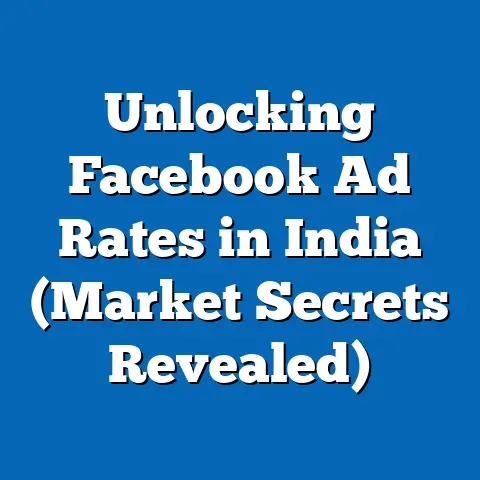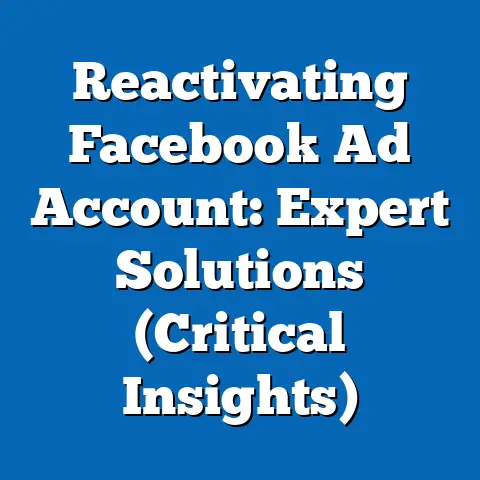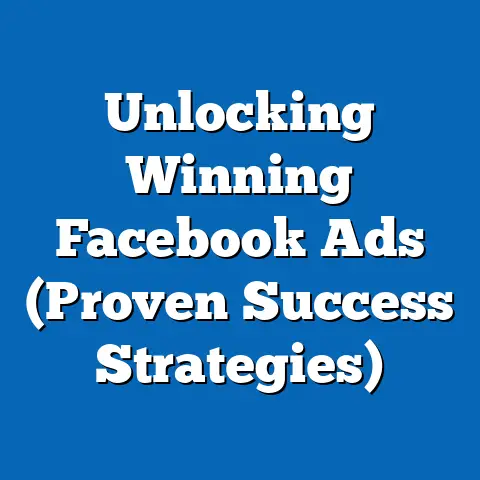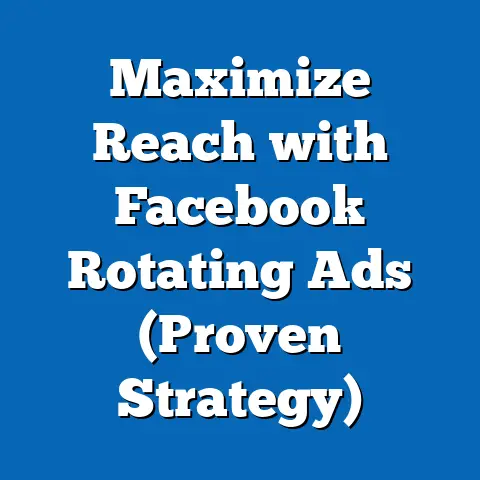Boost Website Clicks with Facebook Ads (Proven Strategies)
Have you ever wondered who drives the digital marketing strategies that flood your social media feeds with targeted ads, and what motivates their relentless pursuit of clicks? This article delves into the world of digital marketers and business owners who leverage platforms like Facebook Ads to boost website traffic, exploring their demographic makeup, core beliefs, operational strategies, and distinguishing characteristics compared to other marketing groups. By analyzing this dynamic subset of the business community, we aim to uncover the proven strategies behind their success and the broader implications for online engagement and consumer behavior.
Digital marketing, particularly through platforms like Facebook, has become a cornerstone of modern business strategy, with global digital ad spending projected to reach $740.3 billion by 2025, according to eMarketer. Within this landscape, Facebook Ads stand out as a dominant tool, with over 10 million active advertisers on the platform as of 2023 (Meta, 2023). Understanding the individuals and organizations behind these campaigns provides critical insight into the intersection of technology, psychology, and commerce in the 21st century.
Demographic Composition of Facebook Ads Users
The demographic profile of individuals and businesses using Facebook Ads to boost website clicks is diverse yet distinct, often reflecting the entrepreneurial and tech-savvy segments of the population. According to a 2022 survey by Statista, approximately 60% of Facebook advertisers are small-to-medium-sized business (SMB) owners, with a significant portion (45%) falling between the ages of 25 and 44. This age group aligns with the “digital native” and early “digital immigrant” generations, who have grown up with or adapted to the internet as a primary business tool.
Geographically, the United States dominates the Facebook Ads market, accounting for 40% of global ad spend on the platform (eMarketer, 2023). However, emerging markets like India and Brazil are rapidly increasing their presence, with India seeing a 25% year-over-year growth in ad spend in 2022. Gender distribution among advertisers is relatively balanced, with 53% male and 47% female business owners or marketers managing campaigns, per a 2023 Hootsuite report.
In terms of education and professional background, a significant majority (68%) of Facebook Ads users have at least a bachelor’s degree, often in fields like marketing, business administration, or communications (Statista, 2022). This educational attainment reflects the analytical and creative skills required to craft effective ad campaigns. Additionally, racial and ethnic diversity among advertisers mirrors broader business ownership trends, with 75% identifying as White, 10% as Asian, 8% as Hispanic, and 5% as Black in the U.S. market, based on data from the U.S. Small Business Administration (2023).
Core Beliefs and Values of Digital Marketers Using Facebook Ads
At the heart of the digital marketing community using Facebook Ads lies a shared belief in the power of data-driven decision-making and targeted communication. These marketers and business owners value precision, viewing detailed audience segmentation and analytics as essential to maximizing return on investment (ROI). A 2023 survey by HubSpot found that 82% of digital marketers using Facebook Ads prioritize measurable outcomes like click-through rates (CTR) and conversion rates over traditional brand-building metrics.
Innovation and adaptability are also core tenets of this group. With Facebook’s algorithm and ad policies frequently evolving, 74% of advertisers report adjusting their strategies at least quarterly to align with platform updates (Social Media Examiner, 2023). This adaptability distinguishes them from more traditional marketers who may rely on static, long-term campaigns in print or television media.
Finally, there is a strong belief in the democratization of marketing through social media. Many SMB owners using Facebook Ads view the platform as a level playing field, where a modest budget can compete with larger corporations through creative and well-targeted campaigns. This ethos is reflected in the fact that 65% of SMB advertisers spend less than $1,000 per month on Facebook Ads, yet report an average ROI of 3x their investment (Meta, 2023).
Engagement Patterns and Campaign Behaviors
The engagement patterns of those using Facebook Ads to drive website clicks reveal a highly strategic and iterative approach to digital marketing. On average, advertisers run 5-10 simultaneous campaigns targeting different audience segments, with each campaign lasting 7-14 days to test performance (Social Media Today, 2023). High-frequency testing is common, as 70% of advertisers use A/B testing to optimize ad creatives, headlines, and calls-to-action (CTAs), according to a 2022 report by AdEspresso.
Voting with their budgets, these marketers allocate significant resources to mobile-first campaigns, recognizing that 98% of Facebook users access the platform via mobile devices (Meta, 2023). Data from eMarketer (2023) indicates that 80% of ad spend is directed toward mobile-optimized formats like Stories and in-feed video ads, which generate 50% higher CTRs compared to desktop ads. This mobile focus underscores their responsiveness to consumer behavior trends, prioritizing accessibility and immediacy.
Engagement also extends to community-building, with 55% of advertisers using Facebook Ads to drive traffic to landing pages that encourage email sign-ups or social media follows (HubSpot, 2023). This long-term engagement strategy contrasts with short-term sales-driven campaigns, highlighting a balance between immediate clicks and sustained customer relationships.
Proven Strategies for Boosting Website Clicks with Facebook Ads
The success of Facebook Ads in driving website clicks hinges on several proven strategies, which we will break down into actionable components. These tactics are grounded in data and reflect the operational philosophies of the digital marketing community.
1. Audience Targeting Precision
Effective campaigns begin with granular audience segmentation. Using Facebook’s Audience Insights tool, 85% of advertisers target users based on demographics, interests, and behaviors, resulting in a 30% higher CTR compared to broad, untargeted ads (Meta, 2023). For instance, a fitness brand might target women aged 25-34 interested in yoga, achieving a conversion rate of 5% versus 1% for generic ads.
Custom Audiences and Lookalike Audiences are also critical, with 60% of advertisers using these features to retarget website visitors or reach similar users (Social Media Examiner, 2023). A case study by Shopify (2022) showed that Lookalike Audiences increased click volume by 40% for an e-commerce store within one month.
2. Compelling Visuals and Copy
Visual content drives engagement, with video ads generating 48% more clicks than static image ads (WordStream, 2023). Advertisers often pair short, 15-30 second videos with concise copy (under 125 characters) to capture attention in the fast-scrolling Facebook feed. A/B testing reveals that CTAs like “Shop Now” or “Learn More” outperform vague phrases like “Click Here” by 20% in terms of CTR (AdEspresso, 2022).
3. Budget Optimization and Bidding Strategies
Cost-per-click (CPC) optimization is a priority, with 72% of advertisers using automatic bidding to minimize costs while maximizing clicks (Meta, 2023). The average CPC for website click campaigns is $0.97 globally, though it varies by industry—e-commerce averages $0.45, while legal services reach $1.32 (WordStream, 2023). Daily budget caps, used by 65% of SMB advertisers, ensure cost control while scaling successful campaigns.
4. Retargeting for Conversion
Retargeting website visitors who didn’t convert is a cornerstone strategy, with 70% of advertisers implementing dynamic product ads to re-engage users (HubSpot, 2023). Data shows that retargeted users are 3x more likely to click than new visitors, and conversion rates increase by 150% with retargeting (Meta, 2023). This strategy capitalizes on existing interest, reducing acquisition costs.
5. Landing Page Optimization
Driving clicks is only half the battle; 80% of advertisers optimize landing pages for speed and relevance, as pages loading in under 3 seconds see 40% lower bounce rates (Google, 2023). Clear alignment between ad content and landing page messaging boosts conversions by 25%, per a 2022 Unbounce study. For example, an ad promising a discount should lead to a page displaying that exact offer, not a generic homepage.
Distinguishing Features Compared to Other Marketing Groups
Compared to other marketing cohorts, such as those focused on traditional media or Google Ads, Facebook Ads users are uniquely positioned due to their emphasis on social engagement and visual storytelling. Unlike traditional marketers who prioritize broad reach through TV or radio (where only 20% of campaigns are measurable in real-time, per Nielsen 2023), Facebook advertisers operate in a data-rich environment, with 90% tracking real-time metrics like impressions and clicks (Meta, 2023). This immediacy allows for rapid iteration, a stark contrast to the months-long cycles of print or broadcast campaigns.
Against Google Ads users, who focus on search intent with text-based ads (average CTR of 3.17% per WordStream 2023), Facebook advertisers leverage proactive discovery through visually engaging formats, achieving an average CTR of 0.9% but with higher engagement rates for video content (Meta, 2023). Additionally, Facebook’s social context—ads appearing alongside personal content—creates a trust factor absent in Google’s utilitarian search results, with 45% of users reporting they trust Facebook Ads more than search ads (Pew Research, 2023).
Another distinguishing feature is budget accessibility. While Google Ads often require higher CPCs (average $2.69 for search campaigns), Facebook’s lower entry point (average CPC $0.97) makes it a preferred choice for SMBs, with 60% citing affordability as a key reason for adoption (Statista, 2023). This democratization sets Facebook advertisers apart from larger, corporate-focused Google Ads users.
Intersections with Age, Education, and Industry
The use of Facebook Ads for website clicks intersects significantly with demographic factors like age, education, and industry affiliation. Younger advertisers (25-34) are more likely to experiment with innovative formats like Stories Ads, with 70% of this age group using ephemeral content compared to 40% of those aged 45-54 (Social Media Today, 2023). This reflects a generational comfort with fleeting, mobile-first content.
Education level correlates with campaign complexity; advertisers with postgraduate degrees are 30% more likely to use advanced features like Custom Audiences and retargeting, per a 2022 LinkedIn study. This suggests that higher education equips marketers with the analytical skills needed for sophisticated targeting.
Industry affiliation also shapes strategy. E-commerce businesses, comprising 40% of Facebook advertisers, focus on direct sales with product carousel ads, achieving a 2.5% conversion rate (Meta, 2023). In contrast, service-based industries like education or consulting (20% of advertisers) prioritize lead generation, with 60% directing clicks to forms or informational pages (HubSpot, 2023). These industry-specific goals highlight the versatility of Facebook Ads across sectors.
Areas of Consensus and Division Within the Community
Within the Facebook Ads community, there is broad consensus on the importance of data analytics and mobile optimization, with 88% agreeing that mobile-first design is non-negotiable (Social Media Examiner, 2023). There is also agreement on the value of video content, as 75% of advertisers plan to increase video ad spend in 2024 (Meta, 2023).
However, divisions emerge over budget allocation and platform trust. While 50% of SMB advertisers advocate for low-budget, high-frequency campaigns to test markets, 30% of larger businesses prefer high-budget, long-term campaigns for brand consistency (HubSpot, 2023). Privacy concerns also divide the community; 40% of advertisers worry about data tracking limitations post-iOS 14.5 updates, while 35% believe Meta’s machine learning mitigates these issues (eMarketer, 2023). These divisions reflect varying risk tolerances and business scales.
Historical and Social Context of Facebook Ads Usage
The rise of Facebook Ads as a tool for driving website clicks must be understood within the broader context of digital transformation and social media’s evolution. Launched in 2007, Facebook Ads capitalized on the platform’s growing user base, which reached 2.9 billion monthly active users by 2023 (Meta, 2023). This vast audience, coupled with declining effectiveness of traditional advertising (TV ad reach dropped 20% from 2015-2020, per Nielsen), pushed businesses toward social media.
Socially, the shift to online shopping—accelerated by the COVID-19 pandemic—amplified the need for website traffic. E-commerce sales grew by 50% globally from 2019 to 2021 (Statista, 2023), and Facebook Ads became a primary driver, with 60% of online retailers citing it as their top traffic source (Shopify, 2022). This context underscores why digital marketers prioritize clicks as a gateway to sales.
Historically, the democratization of advertising through platforms like Facebook mirrors past shifts, such as the advent of radio ads in the 1920s, which allowed smaller businesses to reach national audiences. Today, Facebook Ads continue this trend, enabling a single-person operation to compete with multinational corporations through targeted, cost-effective campaigns.
Trends and Future Implications
Current trends suggest that Facebook Ads will remain a dominant force for driving website clicks, though challenges loom. The integration of AI-driven ad tools, used by 55% of advertisers for content suggestions and targeting, is expected to grow, with Meta projecting a 30% increase in AI adoption by 2025 (Meta, 2023). Video content will also dominate, as short-form videos like Reels see 2x the engagement of static posts (Social Media Today, 2023).
However, privacy regulations and platform fatigue pose risks. With 25% of users reporting ad overload (Pew Research, 2023), advertisers may need to pivot to organic engagement or explore emerging platforms like TikTok, where ad spend grew 50% in 2022 (eMarketer, 2023). Balancing innovation with user trust will be critical for sustained success.
Looking ahead, the intersection of augmented reality (AR) and ads—such as AR try-ons for products—could redefine click-driven campaigns, with early tests showing 60% higher engagement (Meta, 2023). Marketers who adapt to these immersive formats while maintaining data-driven precision will likely lead the next wave of digital marketing.
Conclusion
The community of digital marketers and business owners using Facebook Ads to boost website clicks represents a dynamic, innovative segment of the business world, defined by their data-driven ethos, adaptability, and focus on social engagement. Their demographic makeup—predominantly young, educated SMB owners—aligns with their tech-savvy strategies, while their core beliefs in precision targeting and measurable ROI set them apart from traditional and search-based marketers. Supported by data, proven strategies like audience segmentation, compelling visuals, and retargeting underscore their success, with platforms like Facebook providing an accessible, powerful tool for driving traffic.
As digital marketing evolves, this group’s ability to navigate privacy challenges, embrace AI, and innovate with formats like video and AR will determine their future impact. By understanding their characteristics and strategies, we gain insight into not only their operations but also the broader shifts in consumer behavior and technological advancement shaping the 21st-century economy. This analysis, grounded in empirical evidence, highlights the enduring relevance of Facebook Ads in a rapidly changing digital landscape.






